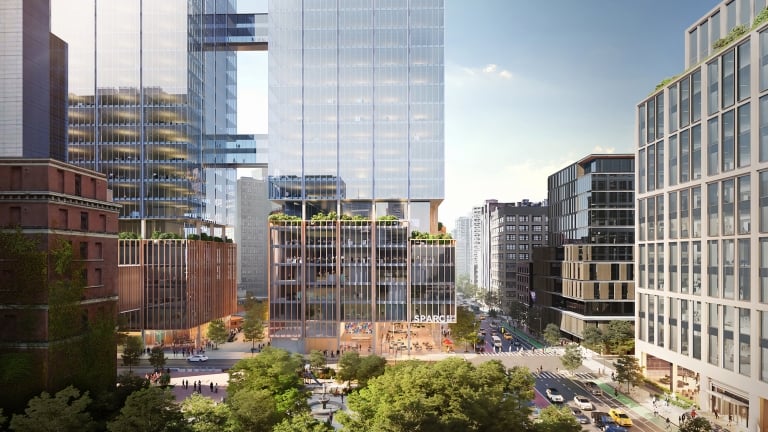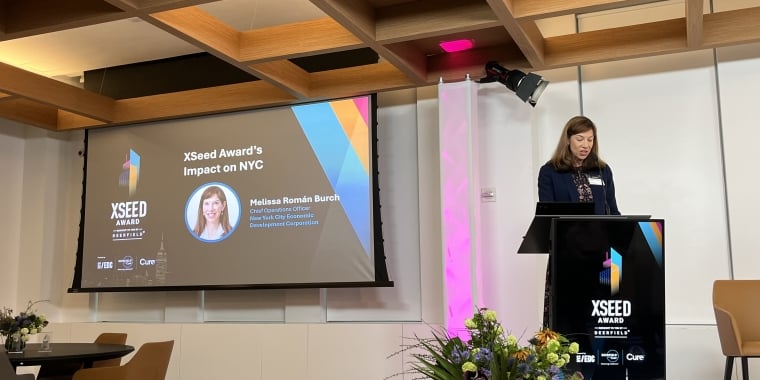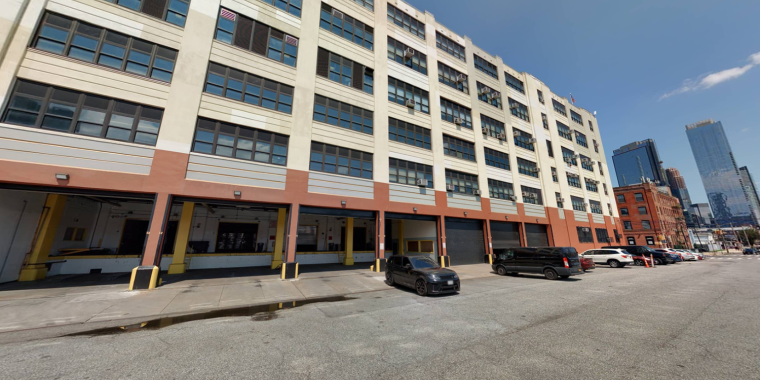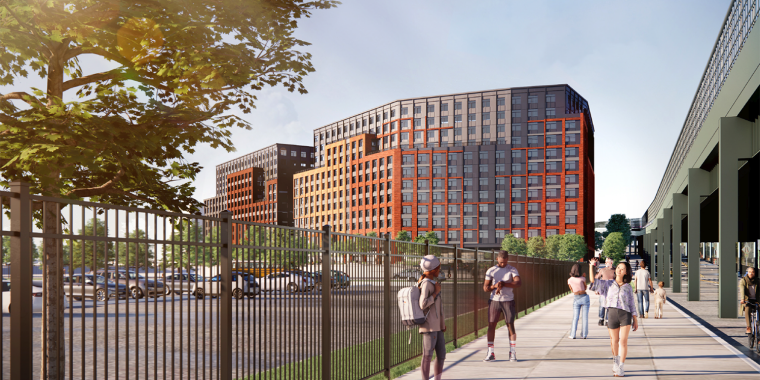Mayor Adams, Governor Hochul Unveil Plan For First-Of-Its-Kind Job and Education Hub for Growing Health Sector

Historic Investment from City and State, in Partnership With CUNY, Will Ensure New York City Becomes Global Leader in Accessible Life Science and Public Health Careers
New, State-of-the-Art Brookdale Campus Will Create Career Pipeline for New York City Students and Anchor Life Sciences Industry
New Project Delivers on Commitments from Mayor Adams’ Blueprint for NYC’s Economic Recovery and State of the City Address
NEW YORK, NY—New York City Mayor Eric Adams and New York Governor Kathy Hochul today unveiled plans for the Science Park and Research Campus (SPARC) Kips Bay, a job and education innovation hub that will be the first-of-its-kind in the state. Driven by an historic investment from the city and state, SPARC Kips Bay will help New York City become a global leader in creating and attracting accessible jobs in life sciences, health care, and public health by creating a pipeline from local public schools to careers in these growing and essential fields.
Through a partnership with The City University of New York (CUNY), SPARC Kips Bay will generate approximately $25 billion in economic impact to the city over the next 30 years; create 10,000 jobs, including 2,000 permanent jobs; and transform Hunter College’s Brookdale Campus on East 25th Street and First Avenue into new, state-of-the-art teaching and commercial facilities. This project will transform an entire city block—with over 1.5 million square feet of academic, public health, and life sciences space, more than doubling the life sciences footprint in Kips Bay—and rebuild a new accessible pedestrian bridge on East 25th street connecting to the East River and Manhattan Waterfront Greenway.
This public-private partnership delivers on commitments from Mayor Adams’ “Rebuild, Renew, Reinvent: A Blueprint for New York City’s Economic Recovery” and his first State of the City address delivered in April. It also follows a series of actions taken in the first months of the Adams administration to invest in and plan the future of the city and the region’s life sciences industry—the country’s leading region for life sciences jobs and funding—particularly in Kips Bay, where the life science ecosystem has seen over $2 billion in investment in the last 15 years.
“This new Science Park and Research Campus in Kips Bay will be not only a hub for the life sciences industry and an anchor for the neighborhood, but also a bridge to the future for our city’s young people,” said Mayor Adams. “SPARC Kips Bay will transform an entire city block into a state-of-the-art destination for the life sciences industry and be a place where workforce development, economic opportunity, and public health come together seamlessly—attracting businesses and uplifting New Yorkers to bring our city back stronger than ever with $25 billion in new economic activity for our city over the next three decades. Thank you to all our partners for the vision and teamwork to ‘Get Stuff Done.’”
“Thanks to this agreement with the city, SPARC Kips Bay will give New York’s life sciences sector a major boost, creating thousands of high-paying jobs, investing in education, and making New York the place where miracles are made,” Governor Hochul said. “My administration remains laser-focused on saving lives and making New York the home of the transformative fields of the future, and with this project, we will achieve both of these goals at the same time.”
“COVID-19 proved how important New York’s public hospitals, research institutions, and CUNY are to the survival and well-being of our city. As a result, it is fitting that Governor Hochul and Mayor Adams have teamed up with CUNY to transform Hunter College’s Brookdale Campus into a public health and education hub to better meet the needs of our students, faculty, and all New Yorkers,” said CUNY Chancellor Félix V. Matos Rodríguez. “Each year, CUNY enrolls about 40,000 students in health and human services programs, and this state-of-the art facility will prepare them to work in New York’s growing life sciences and public health sectors as well as create much-needed jobs in these fields to help our economy. CUNY is proud to be a part of this partnership, which will help New York recover from the pandemic equitably.”

Map of the Kips Bay Science District, including the SPARC Kips Bay campus.
SPARC Kips Bay will cultivate the next generation of the scientific research and health care workforce, creating a single campus with space for the New York City Department of Education (DOE), CUNY, health and biotech companies, and public health institutions—providing pathways to good-paying careers for New York City high school, undergraduate, and postgraduate students. CUNY will specifically offer accessible degrees and continuing education programs in public health and medical research, including for the many young New Yorkers inspired by COVID-19 responders and researchers who helped develop vaccines.
Career opportunities will range from doctors and nurses to biochemists and engineers, as well as a variety of supporting roles in the life sciences and health care fields, like business managers, lawyers, and administrative assistants. With the development of new talent will come new research, translating to more companies, jobs, medicines, and advanced technologies, which will ensure New York City remains the leader in developing treatments and cures for some of the most pressing public health challenges of the time.
Additionally, SPARC Kips Bay will be critical in building a more dynamic and resilient New York City economy. New York City’s health care sector employs over 750,000 New Yorkers, and the metropolitan area’s life sciences sector is a rapidly growing industry with nearly 150,000 additional jobs last year. The city estimates the project will create about 2,000 good-paying, quality jobs just in the campus’ new commercial lab space, which will attract new companies and startups, leading to additional good-paying jobs in the health care and life sciences fields. Construction of the campus will create an additional 8,000 good-paying construction jobs.
“This is truly a transformative project that creates state-of-the-art space for high school, undergraduate, graduate, and postgraduate students, public health institutions, and biotech companies,” said First Deputy Mayor Lorraine Grillo. “It will provide a pathway to career opportunities for generations of New Yorkers.”
“Today marks the beginning of a new era of opportunity for our city and our people. The transformational new campus at SPARC Kips Bay will bring together academia with industry and help New York City become the world’s leading city for life sciences and public health,” said Deputy Mayor for Economic and Workforce Development Maria Torres-Springer. “With the combination of programs and spaces planned on-site, we have a truly unique opportunity to put local talent at the center of the inspiring and impactful work happening in life sciences, health care, and public health and equip them with the training they need to enter these careers.”
“The SPARC Kips Bay campus will help attract and retain the best and brightest in the health and life sciences fields,” said Deputy Mayor for Health and Human Services Anne Williams-Isom. “It will be the home of innovation and collaboration and the heart of instruction for generations of professionals to come in these increasingly important disciplines. Thank you to the teams across the city and the state as well as the science and business communities for coming together to put these plans into practice.”
“SPARC Kips Bay represents a path-breaking approach to economic development in New York City where we create clusters in which commerce and schools work side-by-side to provide career pathways for CUNY and DOE students in the innovative sectors of today and tomorrow,” said New York City Economic Development Corporation (NYCEDC) President and CEO Andrew Kimball. “This is not just an entirely new way of delivering economic development but also a tremendous partnership with the state. Together, we are creating an unprecedented pipeline of diverse talent that will prepare our city for future health emergencies while advancing new medicines, medical devices, innovative therapies, and other products to help treat sick people and improve their lives and care. NYCEDC is confident this historic investment will grow the health and life sciences sectors, diversify our economy, and support its resiliency long-term.”
“NYC Health + Hospitals is proud to be a part of SPARC Kips Bay as we expand Bellevue Hospital’s primary care clinics and add a new clinical simulation center for our employees and CUNY students,” said NYC Health + Hospitals (H+H) President and CEO Mitchell Katz, MD. “Our health system will play a dynamic part in this new campus as we engage our patients and future nurses and physicians.”
“Providing our students with a clear pathway to and preparation for a rewarding career and long-term economic security is our North Star,” said DOE Chancellor David C. Banks. “SPARC Kips Bay will be a result of unprecedented collaboration between our public schools, CUNY, neighboring health and biotech industries, and public health institutions to provide meaningful career pathways for our high school students. I am thrilled that this opportunity will help prepare more of our students for the 21st-century economy and the opportunities of the future.”
“Kips Bay has been home to OCME for more than a century, and, with our new forensic pathology center, we are excited to launch the next chapter for this neighborhood as a global hub for discovery and innovation in forensic science,” said New York City Chief Medical Examiner Dr. Jason Graham. “Our state-of-the-art facility will support doctors and scientists serving New Yorkers at the intersection of public health and safety and ensure that we continue to lead the country in producing board-certified forensic pathologists at a time when this medical subspeciality is critically needed.”
“The New York City region is leading the nation in life science jobs, and, with this project, we will continue to run up the score,” said Department of City Planning Director and City Planning Commission Chair Dan Garodnick. “This new hub is perfectly situated in a health care corridor that includes hospitals, labs, schools, and public health facilities, in a city that has all the talent to bring new innovations to life. This is transformative for the neighborhood and a huge win for New York.”
“This ambitious project is another example of cross-agency cooperation spearheaded by Mayor Adams and Governor Hochul that will transform the Kips Bay neighborhood for generations to come,” said New York City School Construction Authority President and CEO Nina Kubota. “Including a new state-of-the-art school as part of this life sciences and public health campus will provide new, exciting opportunities for students interested in pursuing careers in these growing industries.”
“The public-private investment to develop SPARC Kips Bay will create avenues of economic mobility for New Yorkers and help our economy thrive,” said New York City Mayor’s Office of Talent and Workforce Development Executive Director Abby Jo Sigal. “The on-site training centers and public high school will provide CUNY and DOE students career-connected learning opportunities critical to their professional success and employers in life sciences and health care industries the opportunity to tap the incredible talent of NYC residents.”
SPARC Kips Bay will be anchored by new, modern facilities for over 4,500 students from the Hunter College School of Nursing and School of Health Professions, the CUNY Graduate School of Public Health and Health Policy, and the Borough of Manhattan Community College’s multiple health care programs. The hub will also feature:
- An H+H/Bellevue ambulatory care center that will offer screenings, same-day procedures, diagnostics, and preventive care;
- An H+H simulation training center that will allow CUNY students and others to simulate patient scenarios, utilizing mock operating rooms and labor and delivery rooms;
- A DOE high school providing hands-on learning in health care and sciences to prepare students for careers in these growing sectors;
- A new Office of Chief Medical Examiner (OCME) Forensic Pathology Center, which will be a nation-leading training facility for forensic pathologists, with a 24/7, year-round operational schedule; and
- A new commercial office and wet lab development for the life sciences industry.
New York City has a proven track record of catalyzing industry growth and attracting new business investments by creating or expanding higher education institutions. Opened in 2017, the Cornell Tech campus on Roosevelt Island has served as a major generator of tech and engineering talent and helped grow the tech workforce in New York City to more than 330,000 people. Similarly, the Center for Urban Science and Progress — launched in 2012 in partnership with New York University — established a top-tier applied science and engineering campus that now connects academic programming to real-world applications of urban data science and offers a Master of Science in Applied Urban Science and Informatics.
SPARC Kips Bay will continue this legacy of successful public-private partnerships to help New York grow its life sciences industry, as supported by LifeSci NYC—a $1 billion initiative overseen by NYCEDC to create 40,000 jobs over the next 10 to 15 years.
Over the next year, the city and NYCEDC—working alongside the state and CUNY—will lead a master planning process that will result in a conceptual site plan that will identify the site’s infrastructure needs, open space and urban design, and potential zoning and other entitlement changes needed to implement the project. The planning process will be informed by community engagement and subject matter experts, and supported by the architectural, urban planning, and engineering firm Skidmore, Owings & Merrill.
SPARC Kips Bay is expected to cost $1.6 billion and will be funded jointly by the city and state with additional investment from the private sector in life sciences. SPARC Kips Bay is expected to break ground in 2026 and be completed by the end of 2031.
“This much-needed new facility will allow CUNY to expand our programs in health care and workforce development, connect students to internships and jobs in these growing industries, and expand our robust and growing life sciences research capacity,” said CUNY Board of Trustees Chairperson William C. Thompson Jr. “I’m grateful to Governor Hochul and Mayor Adams for making CUNY an anchor for this new, vibrant development that will be critical to the future success of our city.”
“For years, this community has advocated for a major life sciences center at this site, and I’m thrilled that the day has finally come,” said U.S. Representative Carolyn Maloney. “There is no better place to be siting a state-of-the-art life sciences educational campus with some of the best medical schools, public hospitals, and research centers in close proximity. If we want to continue to be national leaders in the health care professions, we need to be making these types of investments and creating the pipelines that bring talented New Yorkers into the health care industry.”
“This effort will strengthen health care and career opportunities in New York, especially in combination with New York’s expansion of the Diversity in Medicine program,” said New York State Assemblymember Richard Gottfried, chair Committee on Health. “This is also an important investment in public education and public higher education.”
“After years of uncertainty over Brookdale’s future, today represents a big opportunity for New York City,” said New York City Councilmember Keith Powers. “It’s critical that our city continues to be a leader in the life sciences and that our next generation is ready to lead in cutting-edge industries. As this process continues, I look forward to receiving public input, reviewing this proposal with my colleagues, and having important conversations with the community.”
“Life sciences are vital to the future of health care, jobs, and a growing economy. New York City has the resources to be a global hub for cutting-edge medical research and training that will be a boon for good, union jobs and economic growth throughout the region,” said George Gresham, president, 1199SEIU United Healthcare Workers East. “CUNY is integral to training the health care workers of tomorrow and where many 1199SEIU members study, supported by our Training and Upgrading Fund. We look forward to continued collaboration with Mayor Adams and Governor Hochul on this initiative that will strengthen the delivery of health care in New York.”
“As New York continues to emerge from the pandemic, continued investment into critical development projects that not only improve our health care and life sciences infrastructure but also create thousands of good-paying jobs and career opportunities for our working-class people is crucial,” said Gary LaBarbera, president, Building and Construction Trades Council of Greater New York. “This new public health and education hub in Kips Bay is yet another project that will establish New York as a leader in life sciences and health care and provide accessible middle-class career paths to hard-working New Yorkers. We applaud Mayor Adams and Governor Hochul for their continued commitment to driving forward these initiatives that position our city to come back stronger and drastically improve the lives of all New Yorkers.”
“Even in our digitally-connected age, outstanding people, ideas, and concepts flourish with proximity, working side-by-side with and around each other,” said Kevin H. Gardner, Ph.D, director, Structural Biology Initiative, CUNY Advanced Science Research Center. “The SPARC Kips Bay project innovatively builds a new space for all of the key activities of biomedicine—from care to research to training, from discovery to application — to happen all under one roof instead of spread out at different locations. Exciting things are ahead here, from the patients treated to the ideas put into practice and taught to the next generations of health care providers.”
“As a CEO of a New York-based biotechnology company, I am excited to see this historic investment that should further catalyze growth of the life sciences sector in the city,” said R. Noland Townsend, CEO, LEXEO Therapeutics. “Importantly, the ongoing collaboration of industry, academic, and government stakeholders has been critical to facilitating this acceleration in the pace and commitment to building and expanding the life sciences sector in New York.”
“Manhattan Community Board 6 has long been advocating for a modernization of the Brookdale site and is delighted that our leaders are heeding our calls and proceeding in a new and forward-looking way,” said Kyle Athayde, chair, Manhattan Community Board 6. “We thank Governor Hochul, Mayor Adams, Chancellor Matos Rodríguez, and President Raab for advancing and funding a plan that sets up Manhattan Community District 6 to lead in the life sciences industry and to prosper in the 21st century. Community Board 6 is also glad to see that the plan includes some community improvements, which we have advocated for throughout the years, such as an ADA-accessible pedestrian bridge over the FDR Drive to Waterside Plaza. Community Board 6 looks forward to being actively engaged with our government partners during the upcoming planning process.”
“We applaud Governor Hochul and Mayor Adams on this historic announcement,” said Claire Pomeroy, co-chair, Mayor’s Life Sciences Advisory Council, and president, Albert and Mary Lasker Foundation. “The new SPARC Kips Bay is a critical and inspiring investment in the current and future generations of scientists, clinicians, and public servants whose work advances the health of our New York City community and people around the globe. As co-chair of the Mayor’s Life Sciences Advisory Council, I am thrilled to support this new hub of education, career training, and innovation.”
“Today’s announcement by the mayor and governor is very welcome news to those of us who have been advising NYCEDC on its multiple projects to encourage the expansion of life science enterprises in the city through capital investments, real estate development, and training of local talent,” said Harold Varmus, MD, co-chair, Mayor’s Life Sciences Advisory Council, and Lewis Thomas University Professor of Medicine, Weill Cornell Medicine. “A lot of progress has already been made, and the new plans can be expected to accelerate the pace of future development.”
“Driving innovation and supporting the development and growth of New York State’s life science industry is core to our mission,” said Jennifer Hawks Bland, CEO, NewYorkBIO. “Mayor Adams’ and Governor Hochul’s partnership in SPARC Kips Bay is an unprecedented collaborative investment in the advancement of education and career pipelines for this vital industry. This investment will capitalize on New York’s position as a life science leader and home for scientific excellence — paving the way for tremendous growth in talent and, eventually, start-ups and companies.”
“This new research hub will accelerate the growth of life sciences in New York City and create an expanded hub in Kips Bay, currently anchored by the Alexandria Center,” said Maria Gotsch, president and CEO, Partnership Fund for New York City. “Thanks to major public and private sector investments, life sciences have become a bright spot in our city’s economy—creating thousands of jobs and attracting millions of additional dollars of private sector investment. The campus will also enhance the job training and workforce development initiatives needed to close the skills gap and create a pipeline of life sciences talent. We thank Mayor Adams and Governor Hochul for their continued support of the industry.”
“We’re gratified that the partnership between New York State and New York City will utilize the Brookdale Site to expand the existing health and bioscience corridor between 23rd Street and 34th Street,” said Susan Steinberg, president, Stuyvesant Town–Peter Cooper Village Tenants Association. “We look forward to this collaboration providing for education, training, and medical services that will benefit the community.”
“The Waterside Tenants Association is very pleased to learn of the redevelopment plans for the Hunter Brookdale Campus, which will bring a new high school and professional training program to the community and high-quality jobs,” said Janet Handal, president, Waterside Tenants Association. “We are especially pleased that a new ADA-compliant footbridge connecting Waterside to 25th Street will be built as part of the project. We look forward to working with NYCEDC on the community planning process to ensure the concerns and needs of the community are incorporated into the master plan.”
About NYCEDC
New York City Economic Development Corporation is a mission-driven, nonprofit organization that creates shared prosperity across New York City by strengthening neighborhoods and creating good jobs. We work with and for communities to bring emerging industries to New York City; develop spaces and facilities for businesses; empower New Yorkers through training and skill-building; and invest in sustainable and innovative projects that make the city a great place to live and work. To learn more about what we do, visit us on Facebook, Twitter, LinkedIn, and Instagram.


